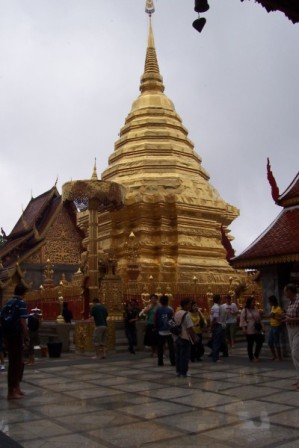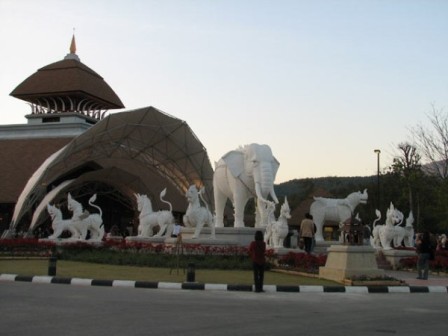Wiang Kum Kam - Chiang Mai
|
|
|
||||||
|
|
|
||||||
|
|
|
According to history King Mangrai relocated the capital of the Lanna Kingdom from Chiang Rai to the old city of Wiang Kum Kam on the banks of the Ping River in 1288. Whilst the new riverside location offered many advantages, the area was low-lying and prone to severe seasonal flooding.
By 1296, King Mangrai had chosen a new site for his capital on the higher opposite bank of the Ping River and declared the newly constructed city of Chiang Mai as the capital of the Lanna kingdom. Years of flooding thereafter left Wiang Kum Kam buried metres underground.
In 1984 Thai authorities were alerted to the discovery of a number of ancient tablets found under Wat Chang Kam just 5km south east of the Chiang Mai metropolitan area. Archaeologists quickly moved in and uncovered the remains of the ancient lost city of Wiang Kum Kam.
Over thirty archaeological sites including many ancient temples were found within the ancient rectangular shaped city wall and just beyond. Finds excavated at the Wiang Kum Kam site suggest that there had been a long history of settlement in the area dating back to the Eighth century.
Any visit to the new archaeological sites should start at the Wiang Kum Kam Information Centre where you can see different exhibitions, details of the discoveries, a multimedia room and other rooms showing the history and importance of Wiang Kum Kam.
The whole site is too large to cover on foot as it is now basically spread out across several suburban neighbourhoods. Cheapest way to get there is by Tuk-Tuk. The best way to tour around the sites is by hiring a local guide with a pony carriage (2-4 people), open-air tram (groups) or bicycle. For a few hundred THB you get you a guide plus pony buggy carriage and a pleasant shady ride for over 1.5 hours.
Among the sites, the two which are still in the best condition and in use today are Wat Chedi Liem which apparently was never affected by the floods, and Wat Chang Kam (or Wat Kan Thom) named after the craftsman, Kan Thom, who built the temple. Besides these two important sites, the others of major significance include Wat E-Khang, Wat Nan Chang, Wat Pu Pia, Wat That Khao, Wat Phaya Mangrai and Wat Ku Padom.
If you like these Ancient Temples, then have a look at more on our Temples page.
For something unique to include in your activities when you visit Chiang Mai, go to Wiang Kum Kam.
By 1296, King Mangrai had chosen a new site for his capital on the higher opposite bank of the Ping River and declared the newly constructed city of Chiang Mai as the capital of the Lanna kingdom. Years of flooding thereafter left Wiang Kum Kam buried metres underground.
In 1984 Thai authorities were alerted to the discovery of a number of ancient tablets found under Wat Chang Kam just 5km south east of the Chiang Mai metropolitan area. Archaeologists quickly moved in and uncovered the remains of the ancient lost city of Wiang Kum Kam.
Over thirty archaeological sites including many ancient temples were found within the ancient rectangular shaped city wall and just beyond. Finds excavated at the Wiang Kum Kam site suggest that there had been a long history of settlement in the area dating back to the Eighth century.
Any visit to the new archaeological sites should start at the Wiang Kum Kam Information Centre where you can see different exhibitions, details of the discoveries, a multimedia room and other rooms showing the history and importance of Wiang Kum Kam.
The whole site is too large to cover on foot as it is now basically spread out across several suburban neighbourhoods. Cheapest way to get there is by Tuk-Tuk. The best way to tour around the sites is by hiring a local guide with a pony carriage (2-4 people), open-air tram (groups) or bicycle. For a few hundred THB you get you a guide plus pony buggy carriage and a pleasant shady ride for over 1.5 hours.
Among the sites, the two which are still in the best condition and in use today are Wat Chedi Liem which apparently was never affected by the floods, and Wat Chang Kam (or Wat Kan Thom) named after the craftsman, Kan Thom, who built the temple. Besides these two important sites, the others of major significance include Wat E-Khang, Wat Nan Chang, Wat Pu Pia, Wat That Khao, Wat Phaya Mangrai and Wat Ku Padom.
If you like these Ancient Temples, then have a look at more on our Temples page.
For something unique to include in your activities when you visit Chiang Mai, go to Wiang Kum Kam.



Quick Links
Our website may use several types of cookies. By using our website you consent to our website's use of these cookies. Please refer to our Privacy Policy for more information.






























































